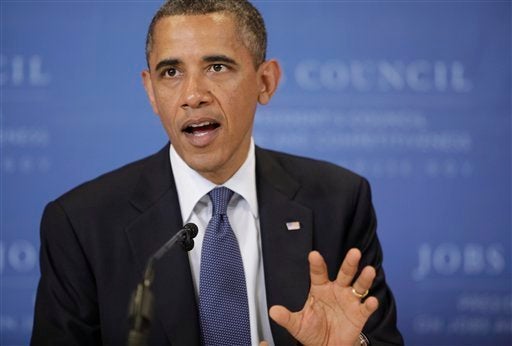
As President Obama puts the finish on a much-touted program aimed at promoting job creation, public expectations appear low, owing to national dismay over a deep unemployment crisis and the partisan division ruling Washington.
But put aside the limitations of political possibility -- granted, a bit like ignoring gravity -- and many economists assert there is much the government could do to put large numbers of Americans back to work.
At the top of many to-do lists is government spending into the tens of billions of dollars to finance large-scale public works projects, a strategy that could address a gaping mismatch: Nearly 14 million Americans are officially out of work, yet a great deal of work needs to be done, from repairing dilapidated roads and bridges, to retrofitting government office buildings with energy-efficient infrastructure.
"If the government spends the money directly on government-funded projects, that puts people on payrolls," said Gary Burtless, a former Labor Department economist and now a senior fellow at the Brookings Institution in Washington. He added that the bulk of hiring and spending is likely to be confined to the domestic economy. "You can't get Brazilian workers to pave a road here in the United States, and lots of capital goods that go into infrastructure would also be produced in the United States," he said.
Critics of infrastructure spending as a proposed fix for unemployment have argued that it can be inefficient: A surge of money let loose through federal and state bureaucracies invites waste and abuse. To which proponents ask, compared to what?
"The other waste that we should keep front and center in our minds is having nine percent of the workforce unemployed," Burtless said. "If some of the money is wasted because it is spent too quickly, you’ve got to put that in context of the complete waste of the talents and abilities of the 11 million Americans who would be working if we were at full employment today."
Infrastructure spending is particularly promising, say proponents, because it is likely to generate jobs in the very areas of the economy that have been hardest hit as the housing boom has gone bust -- construction and manufacturing.
"We still have mass layoffs in those sectors," said Pavlina R. Tcherneva, an economist at Franklin & Marshall College. "It seems very obvious that we can absorb large numbers of workers in those sectors for the public good."
One proposal that has gained favor among some economists in recent months -- among them, Jared Bernstein, previously chief economic adviser to Vice President Biden and now a senior fellow at the Center on Budget and Policy Priorities -- would direct $50 billion toward repairing aging schools, with a particular focus on making buildings more energy efficient. Proponents say this spending would be financed over a decade by closing $46 billion worth of tax loopholes that now favor the traditional oil and gas industry.
According to an outline of the Fix America's Schools Today proposal, the nation's roughly 100,000 public schools confront a backlog of deferred maintenance projects that reaches $270 billion, meaning this money could quickly be absorbed and put to use.
"This is labor-intensive work," Bernstein told the Huffington Post. "And that's a good thing. That means more jobs."
Bernstein helped craft the nearly $800 billion in stimulus spending measures delivered by the Obama administration in early 2009 -- a package that has since become a symbol of disappointment across the ideological spectrum. Those favoring more aggressive government intervention, led by the economists and Nobel laureates Paul Krugman and Joseph Stiglitz, derided it as too small and poorly targeted to reinvigorate economic growth. Conservatives such as John Taylor, a member of the Council of Economic Advisers in the George H.W. Bush administration, and now a senior fellow at Stanford University's Hoover Institution, pronounced it a wholesale waste of money that did not create jobs.
But Bernstein and many other economists maintain that the package prevented the unemployment rate from climbing even higher, and he would favor unleashing a new dose of one of its key components: aid for distressed state and local governments, whose budget troubles have prompted deep and sustained layoffs. This is now the dominant force exacerbating joblessness.
"It's as simple as two plus two," Bernstein said. "You have states that have to balance their budgets and they are still cutting deeply and they either raise taxes or reduce service, and they have been doing more of the latter, leading to layoffs. State and local fiscal relief would be a great way to get much needed, fast-acting medicine into the system."
But as Bernstein acknowledges, such proposals are not on the agenda among the decision-makers in Washington, who have instead been consumed with debate over how to reduce the federal budget deficit.
"I don't see it on anyone's to do list," Bernstein said. "It's very much a should. I'm not sure if it’s a could."
Among job creation initiatives that experts say could emerge from Washington -- albeit, not without considerable congressional wrangling -- are the continuation of a temporary reduction on payroll taxes, and the extension of emergency unemployment benefits for people who have been out of work for six months or longer. Both of these temporary programs are set to expire at the end of the year, absent congressional action. Collectively, they are pumping between $150 billion and $170 billion annually into the economy, Bernstein said.
Beyond the Beltway considerations constraining the scope of policy, some economists advocate more sweeping efforts to generate new jobs by the million.
Tcherneva, the Franklin & Marshall economist, says we need a modern version of the Works Progress Administration, one of the most ambitious undertakings of the New Deal, the federal government's response to the alarming joblessness of the Great Depression. Then, the government directly employed millions of people, aiming them at building out public works projects of enduring value -- dams, highways, parks and firehouses. This time, the federal government could channel funds to state and local government that could then employ private sector firms to build and revamp the needed infrastructure of today, adding light rail to reduce traffic congestion in major cities, upgrading parks and improving access to public education.
"There is such a wide need out there," Tcherneva said. "The private sector is not creating enough jobs. We need an explicit government commitment to put the jobless to work."
Some economists argue that infrastructure spending, while a potentially useful way to generate jobs, is not the most potent channel. A paper published last year by the Levy Economics Institute of Bard College concludes that so-called social care -- meaning early childhood education and home health care for the elderly -- could generate even more jobs per federal dollar spent than infrastructure projects.
"It gives you about twice as many jobs per buck as infrastructure," said Thomas Masterson, an economist at the Levy Institute and one of the paper's authors. "And it's more targeted for women who tend to be disadvantaged."
The paper calls for $50 billion in annual government spending to hire early childhood educators who would provide child care for young children whose parents cannot afford it. The money would also provide home health care aides for the elderly.
Both of these areas of the economy provide large numbers of jobs to people lacking college degrees -- a group now struggling with particularly severe unemployment. Among high school graduates 25 years and older who did not complete college, less than 55 percent are now employed, according to the Department of Labor. That is down from 60 percent four years ago.
Beyond the direct employment benefits, such a program would enable parents now unable to pay for child care to earn income outside their homes, while boosting the skills of children receiving care, Masterson said. Many states are now slashing support for subsidized childcare programs, while also cutting cash assistance programs for poor single mothers.
Other economists assert that the key to job creation is a focus on the people who should be cutting the paychecks, generating fresh incentives for employers to hire.
Two years ago, when the economy was still shedding hundreds of thousands of jobs each month, Aaron Edlin, an economist at the University of California at Berkeley and Edmund Phelps, an economist and Nobel laureate at Columbia University, delivered a paper calling for targeted tax credits for employers who hire low-wage workers.
"The credits would quickly boost the number of low-wage people that businesses employ," the scholars asserted in their paper. "As the market for low-wage people tightened, the competition for them would pull up low-end pay rates."
Edlin told HuffPost that this approach is now more urgently needed than ever.
"We have a serious risk of a double-dip recession," he said. "If one is willing to ignore the political constraints, the best way to get large numbers of people back to work is to give tax credits or subsidies to employers for employing people, and particularly the people who have suffered the most, and that's low wage people."
Debate centers on whether such programs would produce sufficient benefits in an economy now painfully short of demand for goods and services, as consumers battered by years of diminishing fortunes pull back on spending.
Masterson, the Levy Institute economist, said that most employers are too worried about weak sales prospects to respond to an incentive to hire.
"If they can't sell the stuff that they can make now, then why are they going to hire more people?" he said.
But in an economy the size of the United States', some companies are always expanding. The tax incentives might coax those employers to hire more people than they would have otherwise. And once those workers have extra wages, they would distribute them at other businesses, thus creating more jobs -- a virtuous cycle. This is the theory, at least.
"If workers are temporaily on sale," said Brookings' Burtless, "that will give employers a reason to add to their payrolls sooner rather than later."

